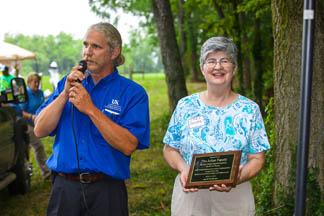Franklin County farm celebrates bicentennial, plans for future
Franklin County farm celebrates bicentennial, plans for future

It was 200 years ago when Charles and Jane Moore Julian purchased 300 acres in Franklin County and became the first in a long line of Julians to continuously farm the property. To celebrate the bicentennial, the latest generation, sister and brother Jane and Bill Julian, recently entertained nearly 800 people on their farm for Franklin County Cooperative Extension’s 55th Annual Farm-City Field Day. In the process, they shared with guests some of the methods they are using to preserve the farmland for future generations.
Keenan Bishop, Franklin County agriculture and natural resources extension agent, said the Julians face what many farm families face these days.
“Several generations ago, pretty much everybody, if they grew up on a farm, wanted to be a farmer,” he said. “Now it’s the other way around. It’s the minority who want to be farmers. Eventually it reaches that generation that has no interest.”
Bill Julian has children, but he and his family live in Virginia. Jane Julian lives on the farm, but has no children. She said it’s been a privilege and a pleasure to grow up on the land where her ancestors lived, and she wants to preserve it as farmland for the future. Together the siblings are taking measures to preserve the farmland for future generations, no matter who might take it over.
 “There are a lot of farmers in the same situation,” Jane Julian said. “We’re seeing a huge land turnover in Kentucky.”
“There are a lot of farmers in the same situation,” Jane Julian said. “We’re seeing a huge land turnover in Kentucky.”
“That’s the underlying theme to this year’s field day,” Bishop said. “There are options and ideas that make it a little bit easier, (when people are faced with this decision).”
The Julians worked through Kentucky’s PACE program to put easements on most of the farm. PACE is the Purchase of Agricultural Conservation Easement Corporation, established by Kentucky in 1994 to keep agricultural lands from being developed for other purposes.
The family also turned over 42 acres of the property in the form of an easement to the Kentucky State Nature Preserves Commission. They dedicated it as a state nature preserve in 2002. The move protected the land, as well as the trees, some of which were there when the first Julians farmed the property. It is one of three remnants of bluegrass savannah in the state being monitored by the commission.
Dan Cox, eastern preserve manager for the commission, said the original plant communities changed rapidly because of land development and agricultural use.
“Much of the flora you see here is not what was here originally,” he said as he led field day participants on a tour of the preserve. “Our management goals on this site are to try to bring back those native plants as best we can, manage the non-native species and see what kinds of seeds still exist in the soil here.”
Through the use of prescribed burns and manual labor, they work to clean out the understory to return the land to the open, prairie-like condition that existed prior to the 1800s, and also knock back non-native species and help germinate the native plants.
What resulted from the Julians’ decision to move cattle off that parcel in 1993 is a living laboratory, said Joyce Bender, commission branch manager for nature preserves and natural areas, who has been working on the preserve with Jane Julian for close to 20 years.
“We don’t know all the answers yet, because so much has gone missing over the years, but we’re going to figure it out,” Bender said. “It won’t be what it was 200 years ago, because it can’t be. Restoration here is kind of a misnomer. We’re really just trying to enhance the native species that are still present on the site.”
The preserve is just one more piece in the mosaic the Julians are creating to preserve their farm for future generations.
“I just feel so lucky to be able to live here and, of course, live in Kentucky, a beautiful, beautiful place with great farmland,” Jane Julian said. “I think my job is to find young people who are going to want to live here and farm for the next generation. That’s what all old farmers have to do, if you don’t have children or grandchildren who want the farm. You have to find somebody else to take it over.”
Environment Events Extension Sustainability


